Concrete being the major consumable material after water makes it quite inquisitive in its nature. The strength of concrete is majorly derived from aggregates, where-as cement and sand contribute binding and workability along with flowability to concrete.
This is an in-depth article on Compressive Strength of Concrete. If you are here to know about how to test the Compressive Strength of concrete Click here or else follow me 🙂
Contents
- What is the Compressive strength?
- Compressive strength of Concrete and its importance:-
- Factors affecting compressive strength of concrete:-
- Coarse aggregate:-
- Air-entrainment:-
- Water/Cement ratio:-
- Why do we test concrete for 7 days, 14 days & 28 days?:
- Compressive Strength of Different Grades of Concrete at 7, 14, 21 and 28 Days:
- Compressive strength testing of concrete:-
- Apparatus
- Preparing of material for Cube test:
- Mixing of concrete:
- Casting of specimen
- Compaction
- Age of test
- Number of specimens
- Procedure for Compressive strength of concrete or Cube test :-
- Calculations
- Compressive strength of Concrete Formula:
- Results of cube test
- Video Explanation:
What is the Compressive strength?
Compressive strength is the capacity of material or structure to resist or withstand under compression. The Compressive strength of a material is determined by the ability of the material to resist failure in the form cracks and fissure.
In this test, the push force applied on the both faces of concrete specimen and the maximum compression that concrete bears without failure is noted.

Concrete testing helps us to majorly focus on the Compressive strength of concrete because it helps us to quantify the ability of concrete to resists Compressive stresses among structures where-as other stresses such as axial stresses and tensile stresses are catered by reinforcement and other means.
In technical point of view,
Compressive Strength of concrete is defined as the Characteristic strength of 150mm size concrete cubes @28 days.
Compressive strength of Concrete and its importance:-
As we all know that concrete is a mixture of sand, cement, and aggregate. The strength of the concrete depends upon many factors like individual compressive strength of its constituents (Cement, Sand, aggregate), quality of materials used, air entrainment mix proportions, water-cement ratio, curing methods and temperature effects.
Compressive strength gives an idea of the overall strength and above-mentioned factors. Through conducting this test, one can easily judge the concrete strength psi and quality of concrete produced.
Factors affecting compressive strength of concrete:-
Coarse aggregate:-
Concrete is made homogenous by combining aggregates, cement, sand, water and various other admixtures. But even with proper mixing, there may arise some microcracks due to differences in thermal and mechanical properties of coarse aggregates and cement matrix, which leads to failure of concrete.
Concrete technologists came up with theoretical concepts regarding size of aggregates, which as the size of aggregate being the major contributor of compressive strength. So if the size of aggregate is increased, then it would lead increased compressive strength.
This theory was later discarded, as experiments proved that greater size of aggregates showed increased strength in initial phases but reduced exponentially.
The sole reason for this strength drop was due to the reduced surface area for bond strength between cement matrix and aggregates and weaker transition zone.
Air-entrainment:-
Air entrainment in concrete was one of the concepts developed by cold countries in order to prevent damages due to freezing and thawing. Later on, as experimentation’s proved multidimensional benefits of air entrainment along with improved the workability of concrete at lower water/cement ratio.
As the achievement of the desired workability at lower water content helped one to achieve concrete with the greater compressive strength which in turn, leads to light concrete with greater compressive strength.
Water/Cement ratio:-
We are all very aware of how excess water can be harmful to the strength of concrete. Cement being the major binding material in concrete needs water for hydration process, but that is only limited to about (0.20 to 0.25) % of cement content. The excess water turns out to be beneficial in contributing to workability and finishing of concrete.
The very aspect where excess water is considered harmful because as the water in the concrete matrix dries, it leaves large interstitial spaces among aggregate and cement grains. This interstitial space becomes primary cracks during compressive strength testing of concrete.
Why do we test concrete for 7 days, 14 days & 28 days?:
Concrete gains maximum strength at 28days. Since in construction sector great amount of capital is at stake, so instead of checking strength at 28 days we can check strength in terms of concrete strength psi at 7 and 14 days to predict the target strength of construction work.
From the below table it is clear that, Concrete gains 16 % of its strength within 24 hrs, whereas concrete gains 65% of the target strength by the time of 7 days of its casting.
Till 14 days concrete shows 90% of the target strength and thereafter the gain in strength slows down and it takes 28days to achieve 99% of strength.
We cant judge the strength of concrete until it becomes stable. And we also won’t wait for 28 days to judge the concrete whether it suitable for construction or not to keep it balanced, concrete is tested at various intervals.
| Age in Days | Percentage of Strength |
|---|---|
| 1 Days | 16% |
| 3 Days | 40% |
| 7 Days | 65% |
| 14 Days | 90% |
| 21 Days | 94% |
| 28 Days | 99% |
The maximum strength gain spike is observed till 14 days, so we test concrete at an intervals of 7 days, 10 days & 14days and If concrete fails to show results of 90% of its overall strength @14 days then that batching is rejected.
Compressive Strength of Different Grades of Concrete at 7, 14, 21 and 28 Days:
| Concrete Grade | Compressive strength in N/mm² at 3 days | Compressive strength in N/mm² at 7 days | Compressive strength in N/mm² at 14 days | Compressive strength in N/mm² at 28 days |
|---|---|---|---|---|
| M10 | 4 | 6.5 | 9 | 10 |
| M15 | 6 | 9.75 | 13.5 | 15 |
| M20 | 8 | 13 | 18 | 20 |
| M25 | 10 | 16.25 | 22.5 | 25 |
| M30 | 12 | 19.5 | 27 | 30 |
| M35 | 14 | 22.75 | 31.5 | 35 |
| M40 | 16 | 26 | 36 | 40 |
| M45 | 18 | 29.25 | 40.5 | 45 |
| M50 | 20 | 32.5 | 45 | 50 |
Compressive strength testing of concrete:-
The test is carried out using 150mm concrete cubes on a Universal testing machine or compressive testing machine.
Apparatus
As per IS: 516-1959 Compressive testing machine (2000Kn),15cm×15cm×15cm steel cube molds or Cylinder having Dia 15cm and length 30cm are used.
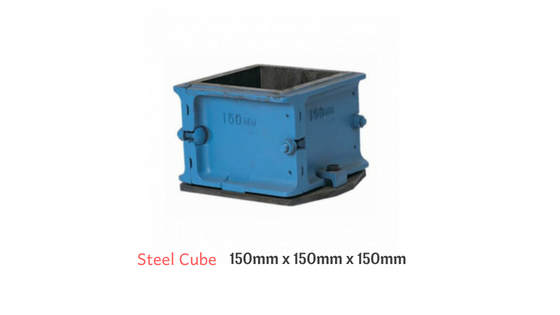
The test includes following steps:-
Preparing of material for Cube test:
All the material must be brought and stored to an approximate temperature of 27 ±3 degree Celsius. Cement must be uniformly mixed with a trowel in order there exist no lumps.
Mixing of concrete:
Machine mixing: The ingredient must not be rotated for more than 2 minutes and the following pattern must be followed
1>Calculated water,2>50% coarse aggregates,3>fine aggregates,4>cement,5>50% coarse aggregates.
Hand mixing: The process must be done on the rectangular pan until a homogenous mix is obtained.
Dry mixing of fine aggregates and cement>addition of coarse aggregate with the even distribution>addition of calculated water in batch till consistency is achieved.
Casting of specimen
The casting molds are chosen to be made of cast iron and must be rubbed with grease on inner side for easy removal of cubes. The specimen must be cast in 3 layers (5cm each) and properly compacted in order that honeycombing formation does not take place.
Compaction
In compacting through tamping bar, 35 strokes must be done in all parts of a cube for proper compacting. This tamping bar has the dimension of diameter 16mm and length of 0.6m.
Age of test
The cube test for Compressive strength can be done on 1,3, 7, 14 and 28 days. In some cases, the strength of greater ages is required which is performed from 13 to 52 weeks.
Number of specimens
It is mandatory to have at least 3 specimens for testing from different batches. The mean of compressive strength achieved by this specimen is used to determine actual strength of the batch.
Procedure for Compressive strength of concrete or Cube test :-
- Place the prepared concrete mix in the steel cube mould for casting.
- Once it sets, After 24 hours remove the concrete cube from the mould.
- Keep the test specimens submerged underwater for stipulated time.
- As mentioned the specimen must be kept in water for 7 or 14 or 28 days and for every 7 days the water is changed.
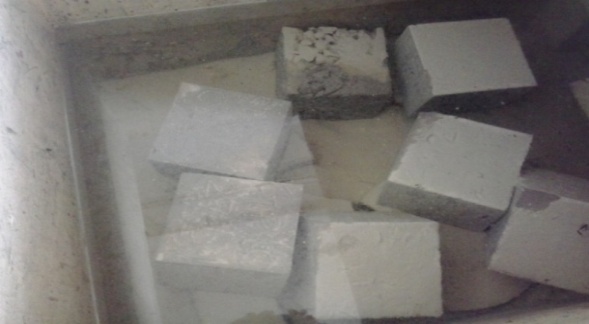
- Ensure that concrete specimen must be well dried before placing it on the UTM.
- Weight of samples is noted in order to proceed with testing and it must not be less than 8.1Kg.
- Testing specimens are placed in the space between bearing surfaces.
- Care must be taken to prevent the existence of any loose material or grit on the metal plates of machine or specimen block.
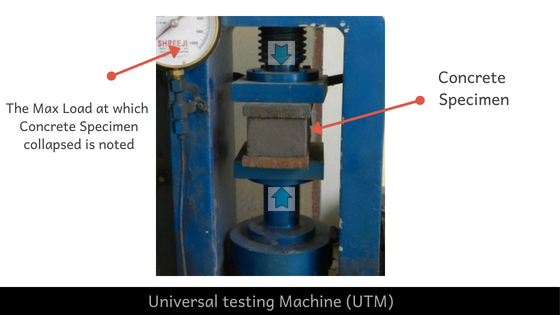
- The concrete cubes are placed on bearing plate and aligned properly with the center of thrust in the testing machine plates.
- The loading must be applied axially on specimen without any shock and increased
at the rate of 140kg/sq cm/min. till the specimen collapse. - Due to the constant application of load, the specimen starts cracking at a point & final breakdown of the specimen must be noted.
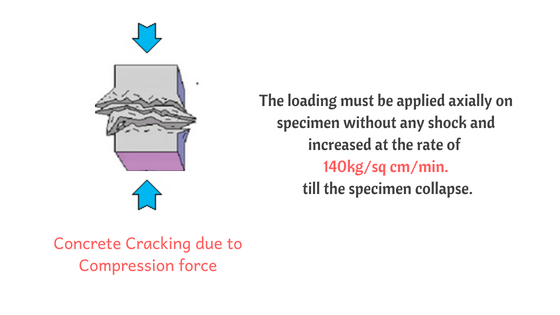
Calculations
Compressive strength of Concrete Formula:
The Compressive strength of specimen can be calculated by dividing maximum load carried by the specimen by cross-sectional area of the specimen cubes.

The surface area of specimen: = 150 x 150 = 22500mm² = 225cm²
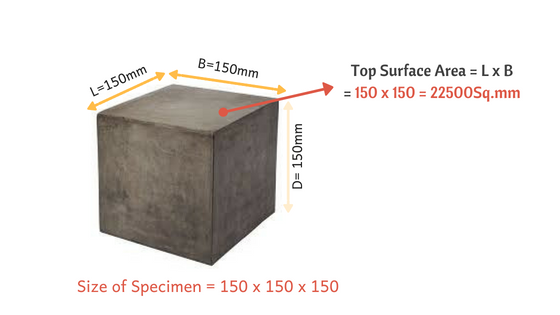
Assume, The Max compression load is 450KN
1KN = 1000N ; 450Kn = 450×100 = 450000N

Compressive Strength of Concrete = 450000 /22500 = 20N/mm² = 203Kg/cm²
Refer google unit conversion tools if required.
The same calculation is done for the specimen at different ages as stated below:
| Details | Specimens | ||
|---|---|---|---|
| Specimen 1 @ 7 days | Specimen 2 @ 14 days | Specimen 3 @ 28 days | |
| Max load that Specimen bear (Assumed Test results) in (KN) | 310KN | 408KN | 445KN |
| Compressive Strength in N/mm² | 310000/22500 = 13.7N/mm² | 408000/2250 =18.13N/mm² | 448000/2250 = 19.9N/mm² |
As we assumed M20 grade concrete mix which bear a max load upto 20N/mm² | |||
| Minimum Strength to be achieved at different days | 65% @7 days | 90% @14 days | 99% @28 days |
| Percentage of Concrete gain (test results) | (13.7x100)/20 = 68.5%>65% | (18.13x100)/20 = 90.6%>90% | (19.9x100)/20 = 99.1%>99% |
A good concrete should not show less than the minimum Compressive strength at respective days. Hence concrete is safe to use. | |||
Important Note: As per IS: 516-1959 Minimum three specimens should be tested at each selected age (that means three specimens at 7 days, three specimens @ 14 days & 28 days) If strength of any specimen varies by more than 15% of average strength, such specimen should be rejected.
Results of cube test
Average Compressive strength at 7 days = _____N/mm²
The average Compressive strength at 28 days = _____N/mm²
Video Explanation:
You can also refer below for Compressive strength of concrete procedure video
For Instant updates Join our Whatsapp Broadcast. Save our Whatsapp contact +9700078271 as Civilread and Send us a message “JOIN”
Never Miss an update Click on “Allow US” and make us allow or Click on Red notification bell at bottom right and allow notifications.
Stay tuned!
Civil Read Wishes you ALL the BEST for your future.



Superb
Very interesting! who new concrete was that complex.
Gajab
Good work dear…..
fantastic I like that this is what I want
Cheers!
Compressive strength (1.3.7.14.28) days
not mention of as per is code and how to proof,
could u be more specific about ur query? Elaborate the same in forum.civilread.com we will get back to u asap.
In which IS code the strength of concrete on 1,3,7,14 and 21 days is mentioned? You have mentioned it as 16% ,40%,65%,90% & 94%. What is the reference?.
these values are as per experience.
Sir my name is mahesh and I need particle mix design note sir .
Mix design concept is already posted on site clearly. You can check that here : https://civilread.com/find-quantity-cement-sand-aggregate/
good
Nice explanation
nice sir
Good job sir….
what’s your fb, sir?
you can follow us on f visit : http://www.facebook.com/civilread